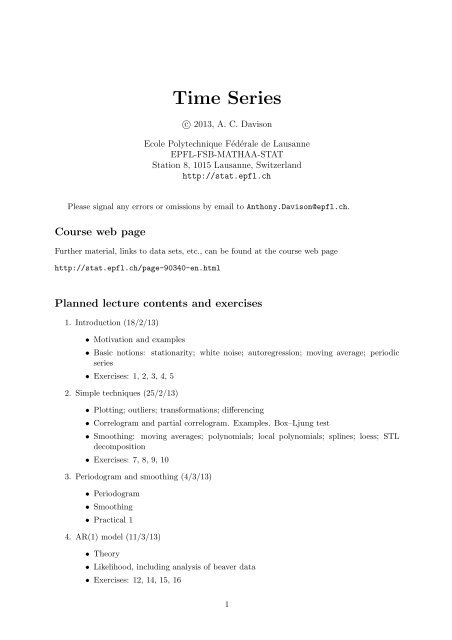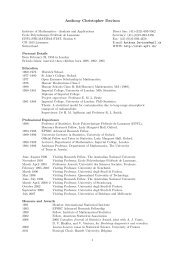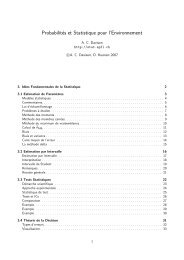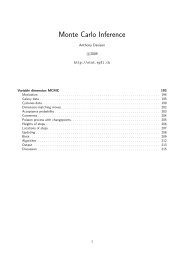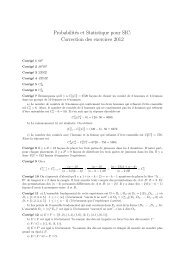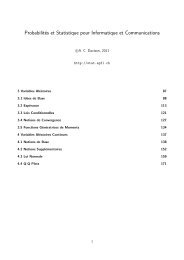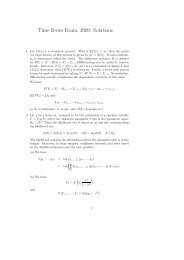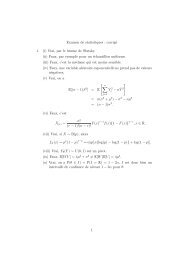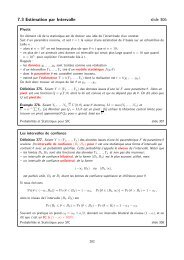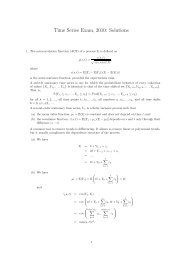Time Series - STAT - EPFL
Time Series - STAT - EPFL
Time Series - STAT - EPFL
You also want an ePaper? Increase the reach of your titles
YUMPU automatically turns print PDFs into web optimized ePapers that Google loves.
<strong>Time</strong> <strong>Series</strong><br />
c○ 2013, A. C. Davison<br />
Ecole Polytechnique Fédérale de Lausanne<br />
<strong>EPFL</strong>-FSB-MATHAA-<strong>STAT</strong><br />
Station 8, 1015 Lausanne, Switzerland<br />
http://stat.epfl.ch<br />
Please signal any errors or omissions by email to Anthony.Davison@epfl.ch.<br />
Course web page<br />
Further material, links to data sets, etc., can be found at the course web page<br />
http://stat.epfl.ch/page-90340-en.html<br />
Planned lecture contents and exercises<br />
1. Introduction (18/2/13)<br />
• Motivation and examples<br />
• Basic notions: stationarity; white noise; autoregression; moving average; periodic<br />
series<br />
• Exercises: 1, 2, 3, 4, 5<br />
2. Simple techniques (25/2/13)<br />
• Plotting; outliers; transformations; differencing<br />
• Correlogram and partial correlogram. Examples. Box–Ljung test<br />
• Smoothing: moving averages; polynomials; local polynomials; splines; loess; STL<br />
decomposition<br />
• Exercises: 7, 8, 9, 10<br />
3. Periodogram and smoothing (4/3/13)<br />
• Periodogram<br />
• Smoothing<br />
• Practical 1<br />
4. AR(1) model (11/3/13)<br />
• Theory<br />
• Likelihood, including analysis of beaver data<br />
• Exercises: 12, 14, 15, 16<br />
1
5. General theory of stationary linear processes (18/3/13)<br />
• General theory of stationary processes/spectral density and linear filters<br />
• AR, MA, ARMA models<br />
• Exercises: 18, 19, 20, 21, 23<br />
6. ARMA models (25/3/13)<br />
• Difference equations. First example of ACF for AR2 model<br />
• Computation of ACF for ARMA models, ARMA(1,1) example<br />
• Practical 2<br />
7. ARIMA modelling (8/4/13)<br />
• Computation of PACF; ARIMA modelling and example<br />
• SARIMA modelling and CO2 example<br />
• Exercises: 25, 26, 27, 28,<br />
8. Regression and forecasting (15/4/13)<br />
• Regression structure, with beaver example. Cochrane–Orcutt algorithm.<br />
• Forecasting. Bootstrap for prediction uncertainty.<br />
• Exercises: 29, 30, 31<br />
9. Financial time series (22/4/13)<br />
• Stylised facts, GARCH models and some extensions.<br />
• Basic stochastic volatility models<br />
• Practical 3<br />
10. Frequency domain analysis (29/4/13)<br />
• Reminders: spectrum, periodogram. Harmonics and leakage. Tapering. FFT.<br />
• Distributional properties and their implications. Smoothing. Whittle estimation.<br />
• Exercises: 32, 33, 34, 36, 39<br />
11. State space models (6/5/13)<br />
• Introduction. Local trend model. Filtering, prediction, smoothing. Kalman filter.<br />
• State error recursion. Missing values. Initialisation. General state space model.<br />
Comparison with ARIMA models.<br />
• Exercises: 40, 41; Question 6 of 2010 exam.<br />
12. Multiple series (13/5/13)<br />
• Multiple time series: cross-correlogram etc.; bivariate spectral theory.<br />
• Transfer function modelling<br />
• Models for multiple time series: VAR, VMA, VARMA, factor models.<br />
• Practical 4<br />
2
13. Long-range dependence/Threshold models (27/5/13)<br />
• Long-range dependence<br />
• Continuation; threshold models.<br />
• Work on mini-project<br />
14. Discrete time series/Wrap-up (Reading)<br />
Final mark<br />
• Basic ideas; GLMs; Special models; Markov chain analysis<br />
• Hidden Markov models and Gibbs sampler<br />
• Work on mini-project<br />
The final mark will be determined as follows:<br />
• there will be a data analysis project, to be undertaken in pairs, involving analysis of a<br />
time series data set (to be found by the students concerned, but validated by me), using<br />
R. A report on the data is to be handed in by 7 June 2013. More about this may be<br />
found below;<br />
• a final exam (probably with 5 questions, of which full correct answers to 4 will give full<br />
marks);<br />
• let E be the mark for the final exam (≤ 3) and P be that for the project (≤ 2). Then the<br />
mark M for the course is 1+E+P rounded to the nearest half-mark in {1,1.5,...,5.5,6}.<br />
Data analysis project<br />
Proposal<br />
As soon as possible, I would like to see a brief proposal about your project, consisting of:<br />
• a description of thedata that you plan to analyse, includingsomesuitable plots andmaybe<br />
some other data exploration;<br />
• an indication of the source of the data set;<br />
• the objectives of your investigation;<br />
• a brief overview of the analyses you anticipate completing.<br />
Bear in mind that this will count for 40% of the course mark, and the number of credits for this<br />
course is 4, so this is much less work than a semester project.<br />
The proposal should be made by 8 April 2013 at the very latest, and the earlier the<br />
better—then I can give feedback, and you can start work.<br />
Data<br />
You could look through books in the library, check out links on the course web page, or look<br />
at the many times series data sets available in R. It is best if the data comprise a few hundred<br />
equally-spaced observations, but you should try to find something that interests you.<br />
3
Report<br />
The report should be typed in either English or French. Do not include hand-written material<br />
unless you want to write out equations and don’t know LATEX. Some notes on report-writing<br />
can be found at http://stat.epfl.ch/page-34953.html, though your report should be much<br />
shorter than for a semester project.<br />
The structure should be<br />
Introduction Briefly state the purpose of the analysis, what type of data were analysed, what<br />
methods were used, and what the results were.<br />
Description of the methods used, using your own words. Give the key elements only: you can<br />
refer to the lecture notes and to books, but should give careful references (to pages and<br />
equations etc.) so I can easily look them up. It is not enough simply to give a list of<br />
sources at the end of the work: references should be mentioned in the text, and only those<br />
mentioned in the text should be listed at the end.<br />
Discussion of the results in more detail. Include crucial plots and tables only, make sure they<br />
are legible, and that their axis labels and captions are clear and informative; each graph<br />
should tell the reader a clear and coherent story. The text can give more details, if they<br />
are needed, and show where the graph/table fits into the overall picture. The discussion<br />
shouldshowhowthestatistical methodsshedlightonthedataandtheunderlyingproblem.<br />
Tables should have appropriate numbers of digits.<br />
Conclusions carrying the take-away message from your analysis, in your own words. Again,<br />
this should be related to the data. Convince the reader that you know what you did and<br />
are aware of its strengths and limitations. Sketch what more you might do, if you had<br />
more time.<br />
Marking scheme<br />
Correctness Accurate, appropriate use of Incorrect,<br />
statistical tools many errors<br />
10 9 8 7 6 5 4 3 2 1 0 Score<br />
Interpretation Correct, appropriate Little or none<br />
5 4 3 2 1 0 Score<br />
Discussion Thoughtful, imaginative Banal<br />
5 4 3 2 1 0 Score<br />
Quality of writing<br />
Good grammar and punctuation, Poor grammar and<br />
including mathematics punctuation<br />
5 4 3 2 1 0 Score<br />
Graphics and tables Clearly labelled, well-chosen, Poorly labelled, no<br />
good captions and discussion, discussion, unmotivated,<br />
appropriate numbers of digits unedited output<br />
10 9 8 7 6 5 4 3 2 1 0 Score<br />
Referencing Full, accurate, and detailed Inadequate citation<br />
references given of sources<br />
5 4 3 2 1 0 Score<br />
Originality and scope Original choice of topic, Standard choice of dataset,<br />
wide range of tools/ideas limited range of tools/ideas<br />
10 9 8 7 6 5 4 3 2 1 0 Score<br />
Grand total (max 50)<br />
4
<strong>Time</strong> <strong>Series</strong>: Bibliography<br />
There are many books on statistical time series analysis, in addition to the many more in other<br />
fields. There are also two main statistical journals devoted to the area: Journal of <strong>Time</strong> <strong>Series</strong><br />
Analysis, and Journal of Forecasting, plus journals of finance and econometrics/economics plus<br />
general statistical journals in which time series articles appear. So plenty of reading is available!<br />
References<br />
Anderson, T. W. (1994) The Statistical Analysis of <strong>Time</strong> <strong>Series</strong> (Classics Edition). Wiley-<br />
Interscience.<br />
Beran, J. (1994) Statistics for Long-Memory Processes. London: Chapman & Hall.<br />
Bloomfield, P. (2000) Fourier Analysis of <strong>Time</strong> <strong>Series</strong>: An Introduction. Second edition. New<br />
York: Wiley.<br />
Box, G. E. P., Jenkins, G. M. and Reinsel, G. C. (1994) <strong>Time</strong> <strong>Series</strong> Analysis: Forecasting and<br />
Control. Prentice-Hall Inc. ISBN 0-13-060774-6.<br />
Brillinger, D. R. (1981) <strong>Time</strong> <strong>Series</strong>: Data Analysis and Theory. Expanded edition. San Francisco:<br />
Holden-Day.<br />
Brockwell, P. J. and Davis, R. A. (1991) <strong>Time</strong> <strong>Series</strong>: Theory and Methods. Second edition.<br />
New York: Springer.<br />
Brockwell, P. J. and Davis, R. A. (2002) Introduction to <strong>Time</strong> <strong>Series</strong> and Forecasting. Second<br />
edition. New York: Springer.<br />
Bühlmann, P. (2002) Bootstraps for time series. Statistical Science 17, 52–72.<br />
Chan, K.-S. and Tong, H. (2001) Chaos: a Statistical Perspective. Springer-Verlag Inc. ISBN<br />
0-387-95280-2.<br />
Chan, N. H. (2002) <strong>Time</strong> <strong>Series</strong>: Applications to Finance. John Wiley & Sons. ISBN 0-471-<br />
41117-5.<br />
Chandler, R. E. and Scott, E. M. (2011) Statistical Models for Trend Detection and Analysis in<br />
the Environmental Sciences. Chichester: Wiley.<br />
Chatfield, C. (1996) The Analysis of <strong>Time</strong> <strong>Series</strong>. Fifth edition. London: Chapman & Hall.<br />
Cowpertwaite, P. and Metcalfe, A. (2009) Introductory <strong>Time</strong> <strong>Series</strong> with R. New York: Springer.<br />
Cox, D. R.(1981) Statistical analysis of timeseries: Somerecent developments (withdiscussion).<br />
Scandinavian Journal of Statistics 8, 93–115.<br />
Cox, D. R., Hinkley, D. V. and Barndorff-Nielsen, O. E. (eds) (1996) <strong>Time</strong> <strong>Series</strong> Models In<br />
Econometrics, Finance and Other Fields. London: Chapman & Hall.<br />
Diggle, P. J. (1990) <strong>Time</strong> <strong>Series</strong>: A Biostatistical Introduction. Oxford: Clarendon Press.<br />
Durbin, J. and Koopman, S. J. (2001) <strong>Time</strong> <strong>Series</strong> Analysis by State Space Methods. Oxford<br />
University Press. ISBN 0-19-852354-8.<br />
Gouriéroux, C. (1997) ARCH Models and Financial Applications. New York: Springer.<br />
5
Harvey, A. C. (1987) Forecasting, Structural <strong>Time</strong> <strong>Series</strong> Models and the Kalman Filter. Cambridge<br />
University Press.<br />
Harvey, A. C. (1993) <strong>Time</strong> <strong>Series</strong> Models. Second edition. New York: Philip Allan.<br />
Kedem, B. (1980) Binary <strong>Time</strong> <strong>Series</strong>. New York: Dekker.<br />
Kedem, B. and Fokianos, K. (2002) Regression Models for <strong>Time</strong> <strong>Series</strong> Analysis. John Wiley &<br />
Sons. ISBN 0-471-36355-3.<br />
MacDonald, I. L. and Zucchini, W. (1997) Hidden Markov and Other Models for Discrete-valued<br />
<strong>Time</strong> <strong>Series</strong>. London: Chapman & Hall.<br />
Percival, D. B. and Walden, A. T. (1993) Spectral Analysis for Physical Applications: Multitaper<br />
and Conventional Univariate Techniques. Cambridge: Cambridge University Press.<br />
Percival, D.B. andWalden, A.T.(2000) Wavelet Methods for <strong>Time</strong> <strong>Series</strong> Analysis. Cambridge:<br />
Cambridge University Press.<br />
Petris, D., Petrone, S. and Campagnoli, P. (2009) Dynamic Linear Models with R. New York:<br />
Springer.<br />
Prado, R. and West, M. (2010) <strong>Time</strong> <strong>Series</strong>: Modeling, Computation, and Inference. New York:<br />
Springer.<br />
Priestley, M. B. (1981a) Spectral Analysis and <strong>Time</strong> <strong>Series</strong>. (Vol. 1): Univariate <strong>Series</strong>. Academic<br />
Press.<br />
Priestley, M. B. (1981b) Spectral Analysis and <strong>Time</strong> <strong>Series</strong>. (Vol. 2): Multivariate <strong>Series</strong>, Prediction<br />
and Control. Academic Press.<br />
Priestley, M. B. (1988) Non-linear and Non-stationary <strong>Time</strong> <strong>Series</strong> Analysis. Academic Press.<br />
ISBN 0-12-564910-x.<br />
Robinson, G. K. (2010) Continuous time Brownian motion models for analysis of sequential<br />
data. Applied Statistics 59, 477–494.<br />
Shumway, R. H. and Stoffer, D. S. (2011) <strong>Time</strong> <strong>Series</strong> Analysis and its Applications, with R<br />
Examples. Third edition. Springer.<br />
Tong, H. (1983) Threshold Models in Non-linear <strong>Time</strong> <strong>Series</strong> Analysis. Springer-Verlag Inc.<br />
ISBN 0-387-90918-4.<br />
Tong, H. (1990) Non-linear <strong>Time</strong> <strong>Series</strong>: A Dynamical System Approach. Oxford: Clarendon<br />
Press.<br />
Tong, H. (ed.) (1995) Chaos and Forecasting. World Scientific Publications.<br />
Tsay, R. S. (2010) Analysis of Financial <strong>Time</strong> <strong>Series</strong>. Third edition. New York: Wiley.<br />
Venables, W. N. and Ripley, B. D. (2002) Modern Applied Statistics with S. Fourth edition. New<br />
York: Springer.<br />
West, M. and Harrison, J. (1997) Bayesian Forecasting and Dynamic Models. Second edition.<br />
New York: Springer.<br />
Zucchini, W. and MacDonald, I. L. (2009) Hidden Markov Models for <strong>Time</strong> <strong>Series</strong>: An Introduction<br />
Using R. London: Chapman & Hall/CRC.<br />
6


